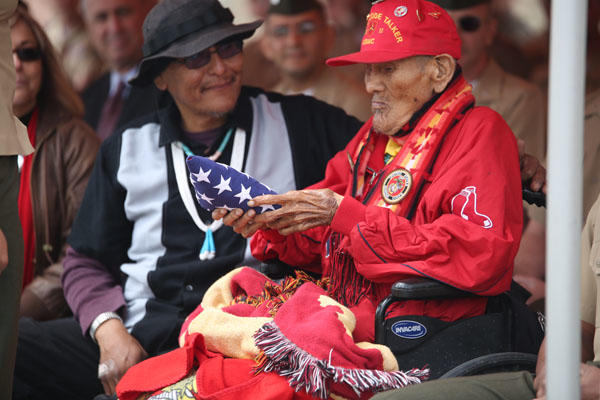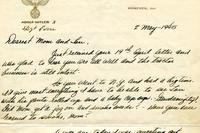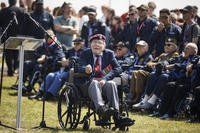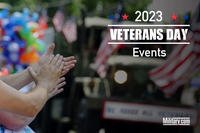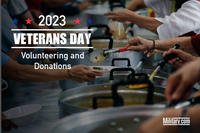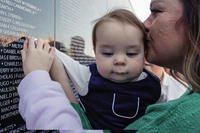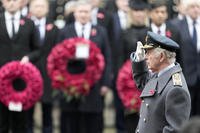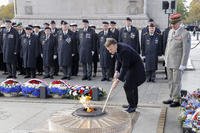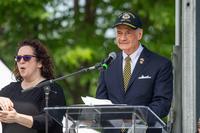This article by Bryce Carpenter originally appeared on VAdvantage Point.
National Cemetery Association intern Maari Weiss researched the life and service of Chester Nez at the Library of Congress. As she always does in her Veteran Spotlight posts, she tells the story behind the service, the story of an American patriot. We're pleased to offer one of Weiss' Veteran Spotlights to honor National Native American Heritage Month.
Nez, like his comrade, John Junior Willie, had the unique opportunity of serving their country by using their traditional language while having to endure occasional discrimination by those who did not understand their role. (See below.) Despite that, Nez contributed in a way that could only be duplicated by others who shared his heritage, Navajo Marines. Nez is interred in Santa Fe National Cemetery (New Mexico), where you can visit his gravesite, but his life is shared with all through the Veterans History Project at the Library of Congress.
Weiss' Veteran Spotlights show the veterans' legacy of these patriots through their own words, showing something of the character and demeanor of these inspiring Americans. Please enjoy getting to know Nez.
[Maari's words follow]
Chester Nez
Jan. 23, 1921 -- June 4, 2014
Chester Nez was a resilient and patriotic man with a remarkable life story. He is notable and relatively unique for his role as one of the 29 original Code Talkers who served in the Marine Corps during World War II, but he also served in the reserves and in the Korean War. On October 1, 2003, Mr. Nez shared his memories in an oral history video interview for the Library of Congress' Veterans History Project.
As a boy, Mr. Nez was sent to a boarding school run by the government's Bureau of Indian Affairs, where he and his classmates faced many hardships and were forbidden to speak the Navajo language. Mr. Nez, however, remained deeply patriotic and, when Marine Corps recruiters came to his school in 1942, he convinced his roommate to join him in enlisting, not realizing at the time that his job in the military would be based on the very language that he could be punished for using in school. He explained that he "wanted to leave the reservation; to see what the other people -- the way they lived, the way they [...] carried on. To see something different ... And on top of that, I wanted to do something for my country. To defend my country and my people -- all the Native American Indians." [Quotes are taken from video interview of Mr. Nez, at the link cited above.]
After spending "almost a month" in boot camp at San Diego Marine Base, Mr. Nez and 28 other Navajos were sent to Camp Elliott, "an advanced training base for the Marine Corps." They still did not know about the special, secret task that they had been chosen to do. Then, towards the end of their training, "this major took us into a -- a great big room, and [...] he told us, 'You people are going -- going to [...] develop a code in your own language.' And this is all he said. He left the room, and he locked the door behind him." The group had not expected this kind of assignment, but they dutifully got to work, spending 13 weeks creating and memorizing the code that they (and future Code Talkers) would use to relay important messages. They came up with a coded alphabet and code words to represent different military terms, relying heavily on the Navajo words for animals. Mr. Nez described the process they used was very thorough and democratic: "... somebody [would] suggest a name -- a certain creature or a bird -- anything like that. ... We [would] all talk about it -- this is how this thing lives, this is how this thing, uh, hunts, this is how this thing flies, and stuff like that ..." The discussion would continue until they had agreed on a word, and then they would move on to the next word. Although they kept notes of their ideas as they went, they could not take anything that they wrote down out of the room with them.
Once the code was complete, Mr. Nez was placed in the First Marine Division with 11 other Code Talkers and sent overseas to the Pacific Theater. The trip was nerve-racking, not the least because he didn't know where he was going, but, after about two weeks at sea, they "got baptized" on the beach of Guadalcanal. Although the other Marines did not know the exact nature of the Code Talkers' job, they all shared a sense of camaraderie, which Mr. Nez called "one of the best thing[s]."
In combat, the Code Talkers tried to stick together, as being with each other helped to put them "more or less at ease." When they weren't just amongst themselves, several Code Talkers went through the frightening experience of being "mistaken for a Japanese" soldier. This happened to Mr. Nez and one of his friends one night, after they had finished "some communication work for the Army." He and his friend were held at gunpoint until the major from the communications center came to vouch for them.
Mr. Nez and his fellow Code Talkers encoded, relayed and decoded a lot of command and control information to one another and to Marine Corps leadership, using their code. They discussed ration and ammunition supplies, messages from commanders about where to lay down firepower, information about casualties and more. Initially, he and his team relied on a big TBX radio that had to be cranked by hand in order to relay their messages, but they later switched to walkie-talkies.
During the Korean War, Mr. Nez was called back into active duty. He had not anticipated being sent back to war, but he was ready to go when called, saying that "[he] felt it was a job to be done, so [he] just went back in."
Like many war veterans, Mr. Nez had difficulty "gett[ing] readjusted to civilian life." However, with the help of a stay in a naval hospital and a traditional Navajo cleansing ritual organized by his dad, he was able to successfully move on with his life after the wars.
Once he was out of the service, Mr. Nez helped his grandmother, grandfather and sister tend to their sheep and goats. Then, he went to Kansas, finishing high school and enrolling in the University of Kansas, where he "studied, ah, drawing and painting and commercial art." After leaving school, he "went back to the reservation" before going out to get a job. He ended up finding work "as a painter" at a veterans' hospital, and he worked there until he retired.
After he retired, Mr. Nez got involved in telling the story of the Code Talkers, traveling to different cities to help educate people about their role in the war. In explaining his passion for this project, he said: "I like for the younger generation to know about the Code Talkers ... to know how we used the language to win the war in the South Pacific."
On July 26, 2001, over 100 families were invited to the United States Capitol "to represent the Code Talkers in Washington, D.C." In a special ceremony on the Capitol Rotunda, Mr. Nez and his fellow Code Talkers were awarded the Congressional Gold Medal for their service. Mr. Nez recalled that "we got our Gold Medal from the President himself. And, uh, I think that was one of the -- the greatest things that ever happened to us, you know, to finally shake hands in, uh, uh, recognition."
All told, Mr. Nez served "four years in the South Pacific, two years in the Korean War and two years as a reserve." Chester Nez passed away on June 4, 2014. He was laid to rest in Santa Fe National Cemetery. We honor his service.
Bryce Carpenter is the educational outreach programs officer for the NCA and a proud Army veteran. Prior to joining VA, he was a teacher, professor and administrator.
Want to Know More About the Military?
Be sure to get the latest news about the U.S. military, as well as critical info about how to join and all the benefits of service. Subscribe to Military.com and receive customized updates delivered straight to your inbox.
